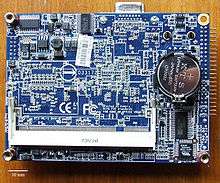Nonvolatile BIOS memory

Nonvolatile BIOS memory refers to a small memory on PC motherboards that is used to store BIOS settings. It is traditionally called CMOS RAM because it uses a volatile, low-power complementary metal-oxide-semiconductor (CMOS) SRAM (such as the Motorola MC146818 or similar) powered by a small "CMOS" battery when system and standby power is off.[1] The typical NVRAM capacity is 256 bytes.[2]
The CMOS RAM and the real-time clock have been integrated as a part of the southbridge chipset and it may not be a standalone chip on modern motherboards.[2]
CMOS battery

The memory battery (aka motherboard, CMOS, real-time clock (RTC), clock battery)[3][4] is generally a CR2032 lithium coin cell. These cells last two to ten years, depending on the type of motherboard, ambient temperature and the length of time that the system is without power, while other common cell types can last significantly longer or shorter periods, such as the smaller CR2016 which will generally last about 40% less than CR2032. Higher temperatures and longer power-off time will shorten cell life. When replacing the cell, the system time and CMOS BIOS settings may revert to default values. This may be avoided by replacing the cell with the power supply master switch on. On ATX motherboards, this will supply 5V standby power to the motherboard even if it is apparently "switched off" and keep the CMOS memory energized.
Some computer designs have used non-button cell batteries, such as the cylindrical "1/2 AA" used in the Power Mac G4 as well as some older IBM PC compatibles, or a 3-cell NiCd CMOS battery that looks like a "barrel" (common in Amiga and older IBM PC compatibles), which serves the same purpose.
See also
References
- ↑ Fisher, Tim. "What is CMOS? (CMOS & CMOS Battery Definition)". About.com. Retrieved 2 September 2015.
- 1 2 "Intel® 100 Series Chipset Family PCH Datasheet". Intel. August 2015. Retrieved 2016-04-16.
- ↑ What are CMOS or Clock Batteries?
- ↑ Ask a question » Replacing the battery of your motherboard (CMOS battery)
External links
- Definition of CMOS & CMOS Batteries
- CMOS memory map (for Bochs PC emulator)
- CMOS rechargeable Battery 3V Lithium, with cable
- How to replace dead CMOS battery and configure BIOS settings (video).
- Tutorial: How to replace the CMOS battery in your laptop
- How to replace the CMOS battery
- Replacing the Motherboard Battery